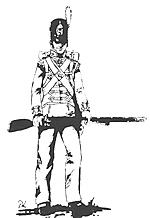 During 1958 Vern Longlee and I fought three campaigns
called THE ITALIAN CAMPAIGNS OF 1808. These were
fictitious Napoleonic war game campaigns, with about six
to seven battles fought out in each one.
During 1958 Vern Longlee and I fought three campaigns
called THE ITALIAN CAMPAIGNS OF 1808. These were
fictitious Napoleonic war game campaigns, with about six
to seven battles fought out in each one.
At that time - and this of course was before the Morschauser Roster System had ever been dreamed of -- we fought with 30mm Napoleonic soldiers which we moved individually. No one had thought of moving trays at that moment in wargaming history. Also, we were fighting on a sand table during these campaigns, and it was easy to move individual model soldiers, since they simply were pushed into the dirt and never fell over ... a curse of the wood table top in those days.
At the beginning of each campaign Vern and I listed seven "divisions" we could use for our Table of Organization. Once a division was committed at a place on the campaign map, it could not be changed, and we had to use it if a battle was fought in that area. Since these divisions were of different strength, we neither of us knew what we were facing until about half way through the battle. Our rules permitted us to keep soldiers off the table (so long as their position was marked on the map as they made movement during the battle) and by doing this, one could keep the other in doubt as to what force he was fighting until the "final reserve" might be committed to the action.
My worthy opponent, Vern Longlee, had a habit of putting on only a thin skirmish line at the start of a battle, then bringing on his reserves after I was well committed tactically. I learned some bitter lessons about "over-extension" of troops and near the end of the first campaign (which this battle report describes) I was somewhat leery of advancing pell-mell after his retreating troops, as I had been squashed several times doing this.
Our musket fire was based on rolling dice for each six soldiers able to fire. The die roll determined the "kill." We used the famed Delebar melee rule, and "post-combat morale" was most important. Whoever won this morale factor after a melee, in particular, could follow up his victory with as many as three or four bonus moves (provided he continued to win each melee).
Thus cavalry were extremely important to us, and we used them extensively in all our attacks, for they often followed up after a winning melee clear into the rear of the opponent's army.
General Vern Longlee commanded the invading British forces while I commanded the defending French Army. We used about 200 infantry and 50 cavalry in each game as an average. We had from three to fOUT cannons for each division, and generally had about 40 Grenadiers or Guards ard 20 to 30 Light Infantrymen amongst the infantry forces. Very descriptive battle reports were kept, with maps complete for most of the important movements.
From the "Jacques Scrubee Archives" I have selected the BATTLE OF FINGER RIDGE to report, to show that even in 1958 (wargames which one might consider today to have been quite unsophisticated) battles were still decided by the guy who had the most men left at the end!
I should add that the entire three campaigns in Italy of 1808 were written by JEAN DE BAPTISTE who happened to have been an ensign in the 33rd Line Regiment of the French Grande Armee. This epic story, called MEMOIRS OF AN OLD CAMPAIGNER was written by Baptiste (alias Jack Scrulby) some 20 years after the campaign (or so it says in the MEMOIRS!) and since Baptiste ardently loved his Emperor, one must realize his battle reports are somewhat one-sided. With this in mind, we give you almost word for word the BATTLE OF FINGER RIDGE as written in MEMOIRS OF AN OLD CAMPAIGNER by Jean de Baptiste.
Near Sienna, Italy: April 12, 1808
Back to Table of Contents -- Panzerfaust #59
To Panzerfaust/Campaign List of Issues
To MagWeb Master Magazine List
© Copyright 1973 by Donald S. Lowry.
This article appears in MagWeb (Magazine Web) on the Internet World Wide Web.
Other military history articles and gaming articles are available at http://www.magweb.com